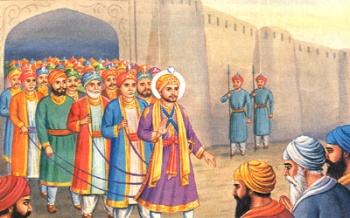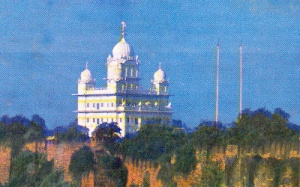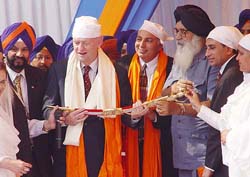Bandi Chhorh Divas
Bandi-Chhor Diwas
See also Diwali This article based on Manvir's Blog and www.sikhpoint.com
Guru Hargobind Sahib with released Kings
The Sikh celebration of the return of the sixth Nanak from detention in the Gwalior Fort coincides with Hindu festival of Diwali. This coincidence has resulted in similarity of celebration amongst Sikhs and Hindus.
When Murtaja Khan, Nawab of Lahore, noticed that Guru Ji had constructed Sri Akal Takhat Sahib, 'The Throne of the Almighty', at Amritsar, and was also strengthening his army, he informed about it to the Mughal Emperor Jahangeer. He also emphasized that he was making preparations to take revenge for his father's torture and martyrdom. When Jahangeer came to know about this he at once sent Wazir Khan and Guncha Beg to Amritsar in order to arrest Guru Hargobind Sahib Ji.
But Wazir Khan who was a well-wisher of the Sikh Guru’s requested the Guru to accompany them to Delhi as Emperor Jahangeer wanted to meet him. Guru Sahib accepted the invitation and reached Delhi.
On their first meeting when Jahangeer saw the Guru, he was completely won over by his youthful charm and holiness. The Emperor decided to become friends with the Guru. So he gave a royal welcome to the Guru. But Chandu Shah could not bear it. His daughter was still unmarried and thus the rotten sore was still bleeding (that Guru Arjan Dev Ji refused the offer to marry his daughter to Guru Hargobind Sahib Ji). At Agra, the Emperor fell seriously ill. The physicians tried their best but they failed to care him. Then Chandu Shah conspired with the astrologers, who were asked to tell the Emperor that his sickness was due to wrong track of stars and it could, be cared only if some holy man goes to Gwallior Fort to offer prayers to the deity. He also pointed out that Guru Hargobind Ji was such a holy man and he should be asked go to Gwallior Fort. At the Emperor’s request the Guru readily agreed and left for the Gawalior Fort.
In the fort Guru Ji met many princes who were detained there due to political reasons. They were leading a very deplorable life. With the help of Hari Dass, the governor of fort, the Guru improved their condition. Hari Daas was a Sikh of Guru Nanak and he become ardent devotee of Guru Hargobind. Once when Chandu wrote to Hari Daas to poison Guru Sahib, he at once placed that letter before Guru Ji.
When several months passed and Guru Ji was not released then Baba Buddha Ji and other devotees met the Guru. They informed him about the despicable condition of the Sikhs, who were waiting for him with great eagerness. The Guru assured them that they should not worry, he would join them soon. Sikhs would gather and carry out Parbaat-Pheris, walking and singing Gurbani, around the Gawalior Fort awaiting for Guru Ji's arrival out.
In the meantime Sai Mian Meer met Jahangeer and asked him to release the Guru. Jahangeer, who had fully recovered, ordered Wazir Khan to release Guru Sahib, who reached Gwallior Fort and informed Hari Daas about the message of the Emperor. Hari Daas was very pleased to hear it. He informed Guru Ji about the message of Emperor. But the Guru declined to leave the fort unless the princes confined in the fort were also released.
When Wazir Khan informed the Emperor about the desire of the Guru, the Emperor was forced to agree, though he didn't want to free the prisoners. So, out of clevery the Emperor put down the condition that "whoever can hold on to the Guru's cloak can be released." The fifty–two princes who had been detained due to political reasons or for committing default, were pining in fort for years. Having compassion for others, Guru Sahib was determined to get the prisoners freed. He had a cloak made with 52 corners, for each King to hold on to. The Guru left the fort with all fifty-two princes. As the Guru liberated the fifty-two princes so he is known as Bandi-Chhor (Liberator).
A Gurdwara known as Bandi-Chhor is built at the place where Guru stayed during his detention. Jahangeer advised Wazir Khan to bring Guru Hargobind in his court at Delhi with great honour. Jahangeer had realised that he wrong for torturing and killing Guru Arjan Dev Ji, who had not committed no crime or offense. He wanted to exonerate himself by indicting this crime on Chandu Shah and other officers. So in order to show his innocence he wanted to meet Guru Hargobind Ji. The Sikhs celebrate this day as Bandi Chhorr Divas i.e., "the day of release of detainees" . So in the evening, illuminations are done with Deewé (earthen oil lamps) or candles and fireworks. The celebrations are held both in the Gurdwaras and in homes.
What do we learn from Bandi-Chhor Diwas?
52 Hindu Kings were freed with Guru Sahib. Guru Sahib could have left the Fort when he was offered the chance. However, Guru Ji thought of others before himself. Others freedom and rights were more important than his own. Guru Ji is always thinking not of his emancipation but everyone's emancipation. This is the attitude and virtue which Guru Ji filled within his Sikhs, by putting into reality this positive message.
Quotes
Canadian PM visits Golden Temple on Divali
Tribune Reporters Amritsar, October 26, 2003
Wishing a happy Divali to all the Canadian Prime Minister, Mr Jean Chretien, on his two-hour goodwill visit to the holy city of Amritsar, paid obeisance at the Golden Temple here yesterday. “What a great day, happy Divali, wrote Mr Chretien in the SGPC’s visitor’s book.
Enjoying the clear sky and warm sunshine, the Prime Minister mingled with devotees, occasionally breaking the security cordon in the Parikarma. He shook hands with the devotees to offer Divali greetings.
Mr Chretein, who is well-versed with the Sikh traditions offered a ‘rumala’ for Guru Granth Sahib which he had specially brought from Canada. He also offered ‘parsad’ and cash as a humble devotee. He was presented a siropa (robe of honour) by the Head Granthi, Giani Puran Singh.
Mr Chretien created a history of sorts as he was the first Prime Minister of a sovereign country to pay obeisance at the Golden Temple. Queen Elizabeth and her husband, Duke of Edinburgh, had visited the temple in 1997.
The Canadian Prime Minister was accompanied by Mr Herb Dhaliwal, Minister of Natural Resources, Mr Gurbax Singh Malhi, Parliamentary Secretary to the Minister of Labour, Mr Baljit Singh Chadda, member of the Privy Council of Canada, along with his senior advisers and a strong contingent of the Canadian media who arrived by a special charted Air Sahara aircraft from New Delhi. Mr Chretein also inaugurated the Guru Arjun Dev Niwas, constructed at a cost of Rs 60 lakh, contributed by the Chadda family at a makeshift stand carrying the plaque.
Addressing the gathering after offering prayers, Mr Chretien said he brought with him warm greetings from his countrymen and the large number of Punjabi community settled there for the people of India. He said the two million-strong Punjabi community, majority of them Sikhs, which constituted 2 per cent of the Canadian population had contributed a lot to the development of Canada. The Sikhs play a decisive role in the elections in many constituencies there. He also spoke a couple of words in French for his countrymen in Canada and for the benefit of the large contingent of electronic media covering his visit.
Mr Chretien who drove straight from Rajasansi airport in a bullet-proof ambassador car was warmly received at the Golden Temple by former Chief Minister Parkash Singh Badal and Mr Manjit Singh Calcutta, honorary secretary of the SGPC, alongwith senior members of the SAD and SGPC. Earlier, Mr Partap Singh Bajwa and Mr Sardool Singh, both Cabinet Ministers, accompanied Mr Chretein after receiving him at the airport. Mr Gurcharan Singh Tohra, SGPC chief, could not be present due to his hospitalisation and Capt Amarinder Singh, Chief Minister, was conspicuous by his absence on the occasion.
Welcoming the Canadian Prime Minister, Mr Calcutta urged the Canadian Sikhs to work hard to make their adopted country a peaceful and prosperous nation. Mr Badal presented a gold-plated replica of the Golden Temple studded with jewels, a kirpan (sword), a silver plaque, a pashmina shawl and a set of books on Sikh religion. Mr Badal also honoured Mr Herb Dhaliwal, Mr Malhi and Mr Gurmant Singh Grewal, a member of Parliament from Canada.
Meanwhile, the tight security arrangements both inside and outside the Golden Temple caused inconvenience to the devotees who had come to celebrate Divali. In one such incident, a senior police official had a fracas with Canadian mediapersons. In the memorandum present to the Canadian Prime Minister the SGPC demanded that there was need for a permanent exhibition on Sikhism in two or three prominent museums. This would deter any prejudice against Sikhs or their traditions in Canada, it said.
Though the Sikhs had contributed immensely for the betterment of the Canadian society, their presence in the public sector was minimal. More jobs should be given to the Sikhs, it added. Sikhs should not be prevented from taking up any job as they wear turban or keep unshorn hair. Sikhs were being subjected to “unreasonable” searches at airports all across Europe and the USA. Canada could sponsor a special year dedicated to an important Sikh anniversary in the United Nations. The year 2004 could be sponsored as a year of inter-faith understanding or of mutual respect, commemorating the 400th anniversary of the Sikh scripture, Guru Granth Sahib.



